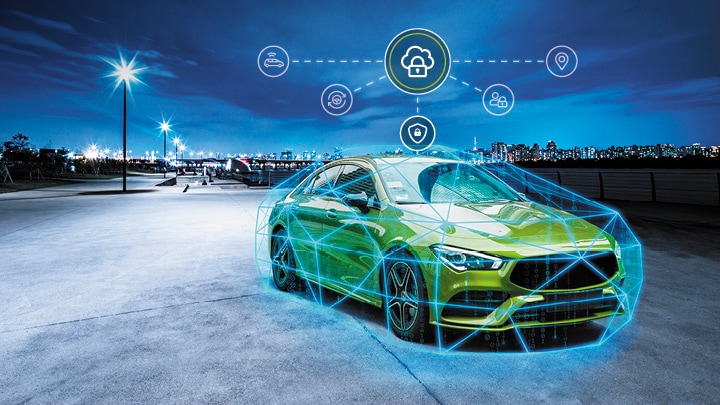The development of complex sensing technology for the automotive industry is proceeding at rapid
speed. The reason? To increase safety on the road and help eliminate accidents. Today, it is
advanced driver assistance systems (ADAS) that are pushing for such solutions. While optical
sensing such as LiDAR and cameras are in use, poor weather conditions impact their performance
requiring alternative technology for system robustness reasons. This is why advancements in
automotive radar, which use radio signals, are seen as a critical element for the future of
automated driving (AD).
As is the way in the world of automotive, radar-based features were initially included in top-end
models, allowing the technology to be tested for suitability and reliability. Integrated into
all-weather ADAS features, such as parking assistance, blind spot detection (BSD), and lane change
assist (LCA), these systems used 24 GHz radar technology based upon silicon germanium (SiGe)
fabrication processes.
Today, radar is a core automotive technology, and semiconductor vendors now deliver highly
optimized chipsets to address the industry shift to 77 GHz band, where a 4 GHz sweep bandwidth is
available.
![]() Blind Spot Detection
Blind Spot Detection
As a company that broadly delivers 77 GHz radar based upon an RFCMOS process, NXP remains at the
forefront of this technology, focusing on full system competence. Delivering in volume to OEMs
worldwide, customers benefit from CMOS-based radar transceivers, dedicated high-performance radar
processors, and our system knowledge. This enables development teams to move quickly from a
minimal viable product to an application tuned to their specific requirements, either
independently or in collaboration with one of our partners.
Our fifth-generation automotive radar solution was conceived with both scalability and fine
angular resolution in mind. The RF transceiver, the TEF82xx, integrates three transmitters and
four receivers that cover the 76 to 81 GHz range. The front end couples with four 40 MS/s
analog-to-digital converters (ADC), and the device includes a phase rotator and low-phase-noise
voltage-controlled oscillator (VCO). For its use in safety-critical applications, the transceiver
has built-in safety monitors and is compliant with ISO 26262 ASIL Level B.
![]() Lane Assist
Lane Assist
Complementing the TEF82xx is the S32R294 radar microcontroller built in 16 nm FinFET technology.
It accepts radar data via MIPI-CSI2, providing multicore processing and a Signal Processing
Toolkit (SPT) hardware accelerator to support the demand for higher angular resolution. It is
automotive AEC-Q100 Grade 1 qualified and meets ISO 26262 ASIL B(D) requirements. The
microcontroller is widely supported by commonly-used automotive compilers and debuggers, an
AUTOSAR® Safety MCAL is available, and a model for the radar accelerator is available for
MATLAB®.
Mastery of radar requires years of experience, expertise is challenging to acquire, and it is
often simpler to build proprietary features on top of a functional solution. The radar technology
from smartmicro, an NXP Gold Partner, provides just such an entry point for OEMs and their
suppliers. With decades of experience in automotive radar, they offer a selection of off-the-shelf
solutions for short- and long-range applications while also offering ADAS engineering services
matched to the needs of their customers.
Working closely with NXP, smartmicro developed two new multi-mode products based upon the TEF82xx
and S32R294. Their new 4D short-range radar is targeting corner applications such as BSD, LCA, and
Front/Rear Cross Traffic Alert (FCTA/RCTA). Capable of four different waveform modes, it offers
separation of 10 cm at ultra-short range and 1.3 m at a long range of 130 m. Using a single
TEF8232 radar transceiver, its antenna array supports up to 12 channels (3 Tx, 4 Rx).
For medium- to long-range multi-mode use, the new 4D front/rear radar is developed. The 48-channel
array (6 Tx, 8 Rx) uses two cascaded TEF8232s together with a single S32R294. The unit offers
medium-range (66 m) and long-range (240 m) modes. Providing an angular separation of 2° the sensor
is ideal for Automatic Emergency Braking (AEB) and Adaptive Cruise Control (ACC).
Using sensor fusion, both new products can, contribute to a full 360° sensing implementation.
Standalone, both sensors deliver point cloud outputs and various synchronization options for
integration into automotive systems. Application-level software is also available, including
object tracking and occupancy grids. Data is shared via CAN-FD or automotive Ethernet interfaces.
![]() Automatic Emergency Braking
Automatic Emergency Braking
With the growing demand of 77 GHz radar-based sensors to fulfill the 360° sensing needed for ADAS
and automated driving , such scalable silicon solutions ensure that knowledge can be reused
easily. At the same time, the bill-of-materials (BOM) is significantly reduced. Additionally, to
ensure fast time-to-market, the NXP design partner smartmicro provides both off-the-shelf sensor
solutions and engineering services for customized radar development. If you’d like to get first
insights into smartmicro’s new products or 77 GHz radar for ADAS and highly automated driving in
general, join NXP and smartmicro for their technical training “Next Generation Radar from NXP:
Systems Solutions, Enablement, and Introduction to Partner smartmicro” at
NXP Connects on
November 9 from 13:00 CET.
#LeaderinRadar #NXPInnovation #radar #cornerradar #77ghz
To learn more about Automotive Radar Systems please visit
here.



